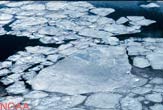Jesus Could Have Walked on Ice, Scientist Says

Rare conditions could have conspired to create hard-to-see ice on the Sea of Galilee that a person could have walked on back when Jesus is said to have walked on water, a scientist said today.
The study, which examines a combination of favorable water and environmental conditions, proposes that Jesus could have walked on an isolated patch of floating ice on what is now known as Lake Kinneret in northern Israel.
Looking at temperature records of the Mediterranean Sea surface and using analytical ice and statistical models, scientists considered a small section of the cold freshwater surface of the lake. The area studied, about 10,000 square feet, was near salty springs that empty into it.
The results suggest temperatures dropped to 25 degrees Fahrenheit (-4 degrees Celsius) during one of the two cold periods 2,500 –1,500 years ago for up to two days, the same decades during which Jesus lived.
With such conditions, a floating patch of ice could develop above the plumes resulting from the salty springs along the lake's western shore in Tabgha. Tabgha is the town where many archeological findings related to Jesus have been found.
"We simply explain that unique freezing processes probably happened in that region only a handful of times during the last 12,000 years," said Doron Nof, a Florida State University Professor of Oceanography. "We leave to others the question of whether or not our research explains the biblical account."
Nof figures that in the last 120 centuries, the odds of such conditions on the low latitude Lake Kinneret are most likely 1-in-1,000. But during the time period when Jesus lived, such “spring ice” may have formed once every 30 to 60 years.
Sign up for the Live Science daily newsletter now
Get the world’s most fascinating discoveries delivered straight to your inbox.
Such floating ice in the unfrozen waters of the lake would be hard to spot, especially if rain had smoothed its surface.
"In today's climate, the chance of springs ice forming in northern Israel is effectively zero, or about once in more than 10,000 years," Nof said.
The findings are detailed in the April 2006 Journal of Paleolimnology.










